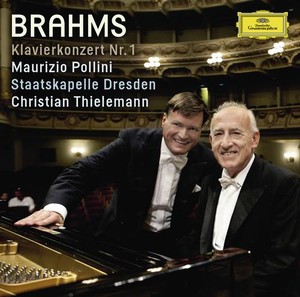Maurizio Pollini’s first recording of Brahms’ D minor concerto, a collaboration with Karl Böhm and the Vienna Philharmonic, came out in 1980. Not leaving well enough alone, DG remade the work with Pollini live in concert, supported by Claudio Abbado and the Berlin Philharmonic. Now we have yet a third Pollini version, released in 2011, this time with Christian Thielemann and the Staatskapelle Dresden, also recorded live.
Technically speaking, Pollini’s 69-year-old fingers yield little quarter to his younger counterparts. If anything, he shapes his first-movement entrance with greater animation, heightened expressive economy, and stronger sense of line, although the rock-solid octave cadenza mid-movement doesn’t quite match Pollini I’s energetic impetus. Pollini III’s Adagio splits the difference between Pollini I’s discreetly flexible cantilenas and the lyrical reserve abetted by Pollini II’s faster tempo. If there’s any doubt that the pianist still can rise to the occasion, check out the Rondo’s trills and cascading runs just before the piu animato at measure 463.
The problem lies with the conductor. Thielemann’s leadership often lacks discipline, focus, and, in some instances, taste. For example, he encourages the timpani to take center stage in the Maestoso’s opening ritornello, and manipulates the strings’ second theme with vulgar, attention-getting dynamic contrasts rather than letting it naturally sing out.
One first-movement passage that usually gets short shrift on disc is the marcato motive passing between the two horns, the violas, the second violins, and first violins starting at measure 192. Both Böhm and Abbado set it up with a carefully gauged accelerando, with string countermelodies particularly out front in the closely miked Abbado recording. By contrast, Thielemann’s speed-up seems relatively abrupt rather than inevitable. In addition, the orchestra lags behind at the start of the Rondo’s coda, despite Pollini’s resolute steadiness. As before in this movement, Pollini resolves the two-bar phrase before the fughetta by adding an unwritten B-flat bass note on the downbeat of measure 238 (Backhaus/Böhm and Rubinstein/Mehta also follow this “tradition”). For Pollini’s work alone this release is worthwhile, but the pianist’s first Brahms D minor remains the best of his three versions.
































